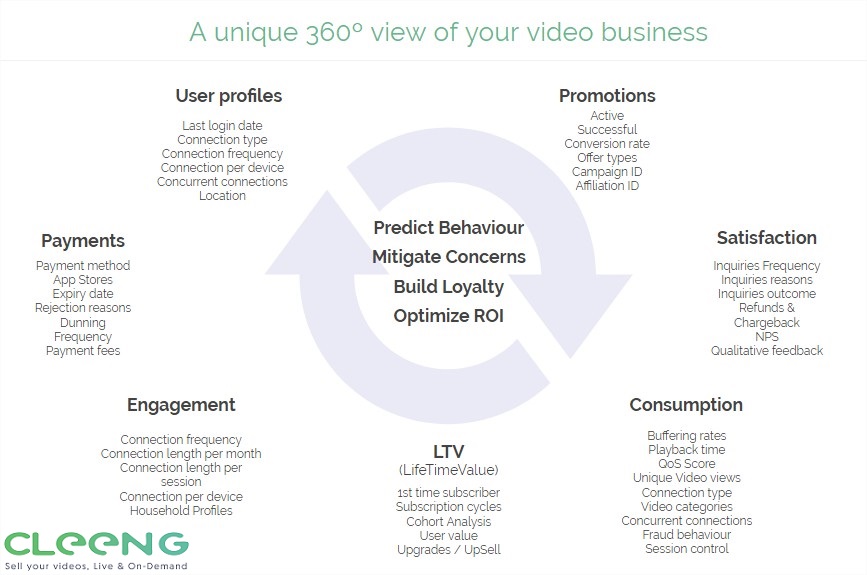
After more than 40 years of operation, DTVE is closing its doors and our website will no longer be updated daily. Thank you for all of your support.
OTT TV: an all-out attack on subscriber churn
OTT TV providers need to tackle churn just as urgently as pay TV companies, says Gilles Domartini, CEO and founder, Cleeng.
 We hear a lot about churn in traditional pay TV but how big a challenge is churn for OTT TV operators?
We hear a lot about churn in traditional pay TV but how big a challenge is churn for OTT TV operators?
Both pay TV and OTT providers have churn as a main challenge. The main differences between the two is closely related to payments and customer experience.
Regarding payments, most traditional pay TV providers have classic, invoice-based payments that are highly predictable and standardised. In the OTT case, most consumers use credit cards to do transactions. On average, these cards expire in three years, meaning you lose 3% monthly due to payment failure alone.
Regarding the customer experience, pay TV providers have a predictable infrastructure as they own the network, provide the set-top boxes etc. In OTT, this infrastructure or consumption platform is unknown to the operator, as viewers may watch their content on desktop, mobile, via apps or the web, with varying quality.
Ultimately, churn can be fatal. It isn’t unusual among the prospects that reach out to us to see churn rates ranging from 20% to 40%. Improving these metrics is essential to reach a positive ROI and continue to grow your subscriber base year-on-year.
What do SVOD and OTT TV companies need to put in place to predict churn with a degree of accuracy?
The answer sounds simple but it turns complex in practice.
Looking at this from an OTT service perspective, the quality standards need to be raised significantly. Churn can become hard to control, as it can happen at any point during the customer journey, due to various reasons like payment failure, a thin content catalogue, low engagement levels, bad viewing experience, lack of customer support, etc.
Having a clear and comprehensive view on the full customer journey is a must. This journey starts from the initial login or registration, choosing a payment method, and ends with interaction with customer support.
Once you have mapped this flow, you need to consolidate the relevant data from all the available data points, and build a 360° view of your users’ behaviour, considering all the possible scenarios.
For example, when you can see a case when a user hasn’t logged on in the past couple of months and his payment card is expiring soon, you can design a campaign to retain that user.
How far can analysis of customer data help OTT operators address the problem?
We believe, very far. The analysis of customer data is critical and can help on many fronts. At the start, it gives you a better insight of your users’ behaviour. That gives you ammunition to tackle churn. Knowing exactly why subscribers left can help you improve your service by fine-tuning your content strategy, improving streaming quality, adjusting your marketing targeting etc.
Once you master that practice, you can start to predict behaviour. Just a few companies are currently doing this well, and this will be key for the battle against the big guns, like Netflix and Amazon.
What are examples of the types of measures can OTT TV providers put in place to reduce churn?
Churn deserves a serious focus and a break-down of all the factors causing it. Once you understand all the different causes and their impact levels, it’s easier to define an improvement plan. Currently, most of the tech vendors focus on the payment-generated factors for churn, like transaction failures, expired cards and low balances and set up mechanisms for streamlining that flow. This is important, yet insufficient.
We have identified two other critical groups of factors:
- Engagement-generated or what defines the usage of your service: frequency and time of viewing, quality of experience (buffering, start/pause).
- Satisfaction-generated or what defines how happy viewers are with your service: the number of support inquires, languages support, NPS score.
Once you master these three dimensions, you can truly tackle churn effectively.
What can Cleeng specifically offer to help operators tackle churn?
Cleeng opted for a video focused, data-driven, 360° take on churn. We have the benefit of focusing strictly on e-commerce video solutions (PPV, SVOD), and that allows us to integrate the tech ecosystem into one solution and build a comprehensive dashboard.
We are super-confident about our new, unique product, named Cleeng ChurnIQ. It empowers OTT broadcasters to tackle churn at all the phases of the customer journey, from login, to payment, consumption, ending with customer care.
We have integration with authentication, payment, front-end, QoE, and marketing solutions to achieve this. It’s all about prediction and action.
We consolidate all these data points and present the insights via an easy-to-digest dashboard designed for the OTT decision maker. Together with the prediction tools, decision makers are fully equipped to take actions that reduce churn, minimise workload and optimise ROI.
We encourage you to see ChurnIQ in action. Book a demo at the upcoming NAB Show.
This Q&A is sponsored content.


